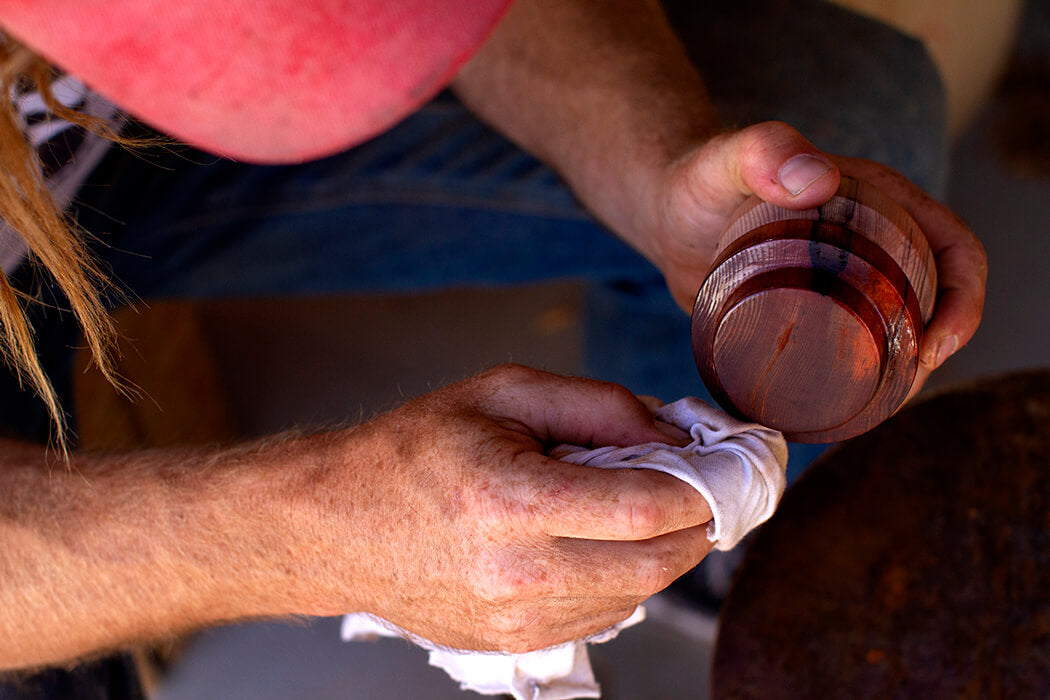
DAN ANDERSON'S CONTEMPLATIVE COMMUNION WITH NATURE
Written and photographed by Dustin Beatty
When you look at a tree, it’s hard to imagine it as anything other than a majestic display of evolutionary beauty. Its branches stretch towards the heavens, soaking in the sunlight from above and converting it to energy which, combined with water and nutrients, travels through the soil below, vibrating in a slow growth that is invisible to the naked eye but evidenced in its rings as the tree comes of age. When that same tree falls, weather – and a host of organisms – will return its trunk to the soil in a delicate dance that perpetuates the cycle of rebirth and makes room for new life of all kinds. But sometimes, this period of decomposition is interrupted by human intervention, and the tree is given a new life of a certain kind: an heirloom piece carved by the artist Dan Anderson.

Wood objects as relics are central to Anderson’s practice. Still, it’s hard to imagine that first cut as a thing of beauty while he rips through a one hundred pound stump gripping a grunting chainsaw, wood chips gathering at his feet like the first dusting of snow. Like a sculptor begins with a nondescript lump of clay or marble, this is the first step in “identifying the essence in the material,” he modestly puts it.
"Sometimes it’s a spiritual exchange working with a material that is life"
“Sometimes it’s a spiritual exchange working with a material that is life,” he explains further. Wood has its own form of aggregate evidenced in the patterns of its rings and knots as it grows out from the center responding uniquely to a host of environmental factors. “Those happen independent of the shape you put on it. There’s a kind of feedback that happens between me as a human and this natural form.”

Once a stump is roughly cut, it’s lifted onto a lathe where it spins and starts to take form only by human instruments. Anderson uses a range of gouges and chisels that dig deep to create sharp edges on some pieces while others are more finessed into round, billowing feminine angles. When asked about his process, Anderson explains,“the lathe is like a potter's wheel. I can esoterically record my feelings and thoughts into those objects. I think about that as transmissions of energy.”
"I can esoterically record my feelings and thoughts into those objects"
Each finished piece is then loaded into a solar kiln where the desert heat bakes away any moisture and relocates any critters still living within the wood. Auto body-grade sandpaper is used to polish each one that is further accentuated by applying oil and sometimes honed to a mirror-like finish.

Though they both serve different functions, his tall totems and shorter sculptural furniture all go through a similar process, often landing in the pages of high-end design magazines, exquisite gallery settings and elite hospitality locations. Each piece inspires an internal dialog and a curiosity for context. "When I first started, I was most interested in thinking about ruins and I created a narrative in my mind about stumbling into an alien landscape like Stonehenge. I like the idea of making primitive work but not referencing that work as I understood it. It’s more about imagining it in a fictitious historical or future place," he adds.
Anderson’s history of making things dates back to his youth growing up in the woods of Eastern Washington where he recalls memories of his father building his childhood home with his own hands. Later in life, art school informed a few ideas that were further manifested as full-scale installations when he was afforded the ability to experiment at his Portland-based design studio, Von Tundra.

Through that experimentation—and the odd job detours that are as often compulsory stops on the long road to becoming a successful artist—Anderson freed himself from the economic constraints of city life by relocating to the high desert enclave of Joshua Tree, CA. He quickly found his footing working in the studios of Alma Allen and Andrea Zittel, two artists internationally lauded for their exploration of form, function and how objects relate to space.
Anderson’s time with both Allen and Zittel further inspired a marriage between practice and environment, leading to a flow state that blurred the line between everyday life and art. Often, 4x4 trips across the desert not only lead to finding source material but also served as an archeological practice that brought the outside in.
"There might be some timeless wisdom in plants that has been lost but can be found, nurtured and maintained"
As you look around his desert home and adjacent studio, it’s fairly easy to gather that Anderson is living his art. His symbiotic practice is intended to be reciprocal much like our communion with nature and the more we learn about unlocking its secrets. After all, “there might be some timeless wisdom in plants that has been lost but can be found, nurtured and maintained,” he suggests. Ultimately, we’re all still learning what that looks like and turning to artists like Anderson to bring us closer to that discovery.
See more of Dan's work: danjohnanderson.com







